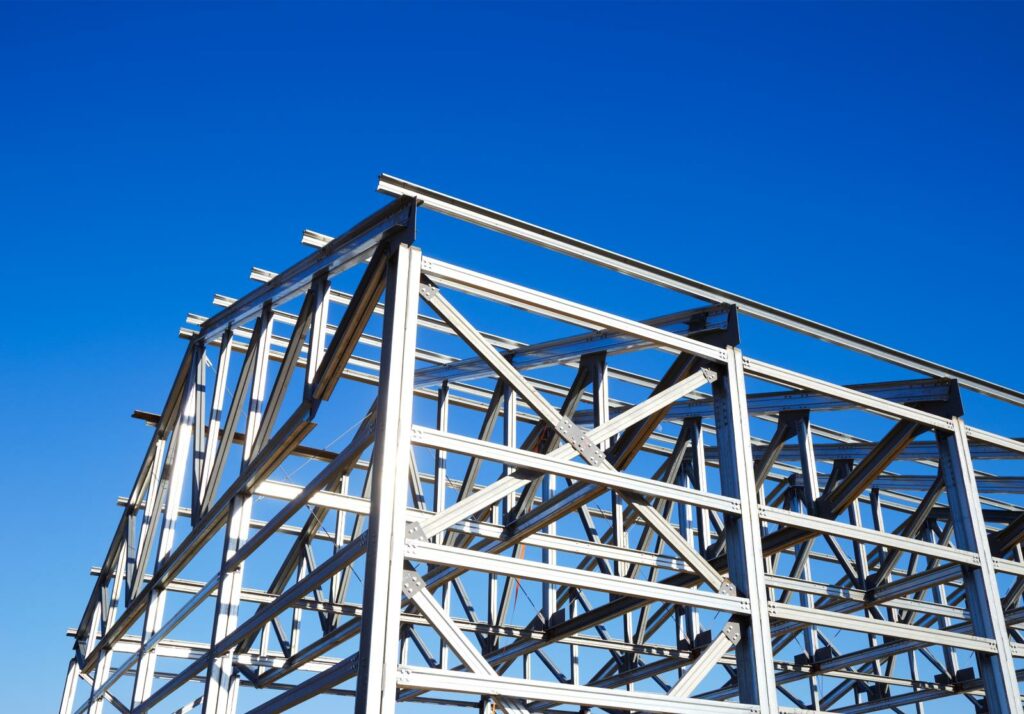
Contents
When considering the longevity and energy efficiency of metal structures, selecting the right materials and design elements can make a significant impact. From sustainable metal roofing options to innovative energy recovery systems, the choices you make can not only reduce operational costs but also contribute to a more environmentally friendly building. By exploring the top 10 energy-saving metal structures, you’ll uncover valuable insights into how to create a durable and efficient space that stands the test of time while minimizing its environmental footprint.
Key Takeaways
- Energy-efficient insulation materials reduce heating and cooling costs effectively.
- Natural ventilation systems enhance air quality while cutting energy consumption.
- Smart building automation optimizes energy use based on occupancy and conditions.
- Energy-efficient lighting fixtures significantly decrease electricity usage.
- Quality windows and doors improve insulation, reducing energy loss.
Sustainable Metal Roofing Options
When selecting sustainable metal roofing options, contemplate the longevity, energy efficiency, and recyclability of the materials. Energy-efficient coatings play a vital role in reducing the overall energy consumption of a building. These coatings are designed to reflect sunlight, keeping the interior of the structure cooler and reducing the need for excessive air conditioning. By choosing metal roofing with energy-efficient coatings, you can greatly decrease your energy bills while also lessening your carbon footprint.
Recycled metal options are another important aspect to ponder when aiming for sustainability in your roofing choice. Opting for recycled metal not only reduces the demand for virgin materials but also minimizes the environmental impact of metal extraction and processing. Recycled metal roofing can consist of post-consumer scrap metal, industrial by-products, or salvaged metal from demolished structures. By incorporating recycled metal options into your roofing system, you contribute to the circular economy and promote the efficient use of resources.
Insulated Metal Panels for Efficiency
When considering insulated metal panels for your structures, it’s important to understand the benefits they offer.
These panels provide exceptional thermal insulation, contributing to significant energy savings.
Panel Insulation Benefits
Insulated metal panels offer a highly efficient solution for improving energy savings in metal structures. By incorporating advanced panel insulation techniques, these panels enhance thermal performance and provide insulation benefits that contribute to overall energy efficiency.
The tight seals and high R-values of insulated metal panels help reduce heat loss in cold weather and minimize heat gain during warmer months. These panels act as a barrier against air infiltration, preventing energy wastage and maintaining a consistent indoor temperature.
With their superior insulating properties, insulated metal panels not only enhance the sustainability of metal structures but also lead to significant cost savings by reducing the energy required for heating and cooling.
Energy Efficiency Tips
Implementing energy efficiency tips utilizing insulated metal panels is crucial for maximizing the thermal performance and cost-saving potential of metal structures. To enhance energy efficiency further, consider the following:
- Energy-Efficient Windows: Installing energy-efficient windows alongside insulated metal panels can greatly reduce heat transfer, keeping your building comfortable and reducing energy costs.
Sustainable HVAC Systems: Pairing insulated metal panels with sustainable HVAC systems ensures excellent temperature control while minimizing energy consumption, contributing to a greener environment.
Proper Insulation Maintenance: Regularly inspecting and maintaining the insulation of your metal panels can prevent heat loss or gain, ensuring long-term energy efficiency and cost savings.
Cool Metal Roofs for Energy Savings
To enhance energy efficiency in buildings, consider installing cool metal roofs designed to reflect sunlight and reduce heat absorption. Cool metal roofs are coated with reflective coatings that bounce sunlight off the surface, preventing heat buildup within the structure. By choosing cool metal roofs, you can greatly lower your energy costs by reducing the need for air conditioning during hot seasons.
Moreover, cool metal roofs are beneficial for rainwater harvesting. The smooth surface of metal roofs allows rainwater to flow easily into gutters and downspouts, which can then be collected and stored for various non-potable uses. This sustainable practice not only conserves water but also reduces the strain on municipal water resources.
Cool metal roofs can decrease a building’s cooling energy consumption, leading to substantial cost savings over time. Additionally, these roofs have a longer lifespan than traditional roofing materials, reducing the frequency of replacements and the associated environmental impact.
Energy-Efficient Metal Building Designs
Metal building designs optimize energy efficiency through advanced insulation techniques and strategic placement of windows and doors to maximize natural light utilization. When considering energy-efficient design and metal building sustainability, there are key features that contribute to a more eco-friendly and cost-effective structure:
Reflective Roofing: Utilizing reflective metal roofing materials helps reduce heat absorption, lowering cooling costs in warmer climates. This energy-saving feature also extends the lifespan of the roof by minimizing temperature fluctuations, thereby enhancing the overall sustainability of the building.
Insulated Panels: Incorporating insulated metal panels in the walls and roof drastically improves thermal performance. These panels provide a continuous layer of insulation, preventing heat loss in winter and heat gain in summer. By reducing the workload on heating and cooling systems, these panels enhance energy efficiency and contribute to long-term savings.
Daylight Harvesting: Implementing daylight harvesting systems in metal buildings maximizes natural light penetration, reducing the need for artificial lighting during daylight hours. This not only decreases energy consumption but also creates a more comfortable and productive indoor environment for occupants. Daylight harvesting aligns with energy-efficient design principles, promoting sustainability and cost-effectiveness in metal structures.
Daylighting Solutions in Metal Structures
For optimizing natural light utilization in metal structures, consider effective daylighting solutions that enhance energy efficiency and indoor comfort. Natural lighting plays an important role in reducing the need for artificial lighting, thereby lowering energy consumption.
When designing metal structures, incorporating features such as skylights, clerestory windows, and light shelves can maximize the penetration of natural light into the interior spaces. By strategically placing these elements, you can achieve a balance between daylighting and glare control, ensuring a comfortable environment while minimizing the reliance on artificial lighting sources.
In addition to energy savings, proper daylighting solutions contribute to enhancing thermal comfort within metal structures. Natural light not only provides illumination but also influences the overall feel of a space. By harnessing natural lighting effectively, you can reduce the dependence on mechanical cooling systems, leading to decreased energy costs and a more sustainable building operation.
Moreover, optimizing natural lighting can positively impact occupants’ well-being and productivity by creating a visually stimulating and pleasant indoor environment.
To enhance the energy efficiency and indoor comfort of metal structures, prioritizing natural lighting through thoughtful daylighting solutions is essential. By embracing these strategies, you can create spaces that aren’t only sustainable but also conducive to the well-being of those who inhabit them.
High-Performance Metal Building Envelopes
When considering high-performance metal building envelopes, focus on insulation for efficiency, protective weather barriers, and sustainable material choices.
Insulation plays an important role in reducing heat transfer and maintaining interior comfort levels.
Additionally, weather barriers are essential for shielding structures from the elements, while opting for sustainable materials aligns with eco-friendly construction practices.
Insulation for Efficiency
How can high-performance insulation in metal building envelopes greatly enhance energy efficiency and reduce heat loss?
Implementing advanced insulation techniques is important for optimizing energy conservation in metal structures. When considering insulation for efficiency, focus on the following key aspects:
Thermal Bridging Prevention: By strategically placing insulation to minimize thermal bridging, you can greatly reduce heat transfer through the building envelope.
Air Sealing Techniques: Properly sealing all gaps and joints in the structure prevents air leakage, ensuring that the insulation functions at its highest efficiency level.
Vapor Barrier Installation: Installing a vapor barrier helps control moisture levels within the building, enhancing the overall performance of the insulation system.
These methods, along with leveraging radiant barrier benefits, play an essential role in enhancing the energy-saving capabilities of metal structures.
Protective Weather Barriers
To optimize the efficiency of high-performance metal building envelopes, ensuring the effective installation of protective weather barriers is essential. Weatherproof seals and thermal barriers play a vital role in enhancing the longevity and energy-saving capabilities of metal structures. Properly sealed joints and connections prevent air leakage, reducing energy loss and maintaining a comfortable indoor environment. Thermal barriers help regulate temperature fluctuations, further improving energy efficiency. Below is an example of how weather barriers can be strategically implemented in metal building envelopes:
| Weather Barrier Type | Description |
|---|---|
| Insulated Metal Panels | Panels with weatherproof seals and high thermal resistance |
| Standing Seam Roof System | Seam roof system with integrated thermal barriers for enhanced energy efficiency |
| Metal Cladding Systems | Cladding systems designed with weatherproof seals for protection against external elements |
| Weather-Resistant Coatings | Coatings applied to metal surfaces to create a durable weather barrier |
| Flashing Systems | Flashing systems to prevent water infiltration and enhance the overall weather resistance |
Sustainable Material Choices
Selecting sustainable materials for high-performance metal building envelopes is essential for enhancing energy efficiency and environmental impact mitigation. When considering sustainable material choices for your metal building envelope, here are some key options to keep in mind:
Opt for sustainable facade options like recycled metal panels or FSC-certified wood cladding to reduce environmental impact.
Choose energy-efficient cladding materials such as insulated metal panels or cool metal roofs to enhance thermal performance and lower energy consumption.
Incorporate eco-friendly building materials like low VOC coatings or green insulation to create a healthier indoor environment for occupants.
These choices promote green construction trends and contribute to long-term sustainability and energy savings.
Passive Solar Heating in Metal Buildings
Passive solar heating can greatly enhance the energy efficiency of metal buildings by harnessing the sun’s natural warmth. When strategically designing a metal structure, solar orientation benefits should be a key consideration. Orienting the building to maximize sun exposure during the winter months can notably reduce heating costs. By incorporating large south-facing windows and minimizing windows on the north side, you can optimize the building’s passive solar potential.
Moreover, thermal mass advantages play an important role in passive solar heating. Utilizing materials with high thermal mass, such as concrete or masonry, within the building’s structure can help store and distribute heat effectively. During the day, these materials absorb heat from the sun, releasing it slowly at night, maintaining a comfortable temperature without the need for additional heating.
To further enhance the passive solar heating in your metal building, consider adding features like thermal curtains or shades to regulate the amount of sunlight entering the space. Additionally, implementing roof overhangs or deciduous trees can offer shade during the summer months to prevent overheating.
Energy Recovery Systems for Metal Structures
When examining energy recovery systems for metal structures, it’s important to analyze the available heat recovery options and their efficiency in operation.
Understanding the mechanisms that allow for best heat exchange and energy conservation can greatly impact the overall sustainability of metal buildings.
Implementing efficient energy recovery systems can lead to substantial cost savings and a reduced environmental footprint.
Heat Recovery Options
Consider integrating a heat recovery system into your metal structure to maximize energy efficiency and cost savings. Implementing waste heat utilization and energy recovery technologies can greatly reduce your building’s energy consumption. By combining thermal insulation and sustainable construction practices, you can create a more environmentally friendly and cost-effective structure.
Here are three key benefits of incorporating heat recovery options:
Increased Energy Efficiency: Recovering and reusing waste heat helps lower overall energy consumption, leading to reduced utility costs.
Enhanced Sustainability: By utilizing energy recovery systems, you contribute to a greener environment and promote sustainable building practices.
Improved Comfort: Heat recovery options can help maintain a consistent and comfortable indoor temperature, enhancing the overall experience for occupants.
Efficiency in Operation
To optimize the operational efficiency of your metal structure, implementing energy recovery systems is essential. By integrating energy-saving lighting solutions and focusing on operational efficiency, you can enhance the overall performance of your structure. Thermal performance optimization and sustainable practices play a vital role in ensuring that your metal structure operates at its peak efficiency levels. Consider the table below for a quick comparison of different energy recovery systems:
| Energy Recovery Systems | Benefits |
|---|---|
| Heat Exchangers | Efficient heat transfer |
| Energy Recovery Ventilators | Improved air quality |
| Heat Pumps | Heating and cooling options |
| Waste Heat Recovery Systems | Utilize waste heat energy |
| Solar Panels | Renewable energy source |
Implementing these systems can greatly reduce energy consumption and promote a more sustainable operation for your metal structure.
Green Roofing Solutions for Metal Buildings
For efficient energy management in metal buildings, integrating green roofing solutions can greatly enhance sustainability and reduce environmental impact. Green roofs offer numerous benefits beyond their eco-friendly nature, making them an excellent choice for metal structures.
Here are three key reasons why green roofing solutions are advantageous:
Enhanced Insulation: Green roofs provide additional insulation for metal buildings, reducing the need for excessive heating or cooling. This insulation helps maintain a consistent indoor temperature, leading to lower energy consumption and cost savings over time.
Improved Air Quality: By incorporating green roofing solutions, you can enhance the air quality both inside and outside the metal building. The vegetation on the roof acts as a natural air filter, trapping pollutants and dust particles, which can considerably benefit the occupants’ health and well-being.
Meeting Green Building Certifications: Green roofing solutions align with various green building certifications, such as LEED (Leadership in Energy and Environmental Design) and BREEAM (Building Research Establishment Environmental Assessment Method). Achieving these certifications not only demonstrates your commitment to sustainability but also increases the overall value and desirability of the metal building.
Solar Panel Integration in Metal Roofs
Exploring how these components interact to create a harmonious and efficient energy-saving solution.
| Solar Panel Efficiency | Durability | Aesthetics |
|---|---|---|
| High efficiency panels can convert more sunlight into electricity, maximizing energy production. | Metal roofs provide a durable base for solar panels, protecting them from environmental factors. | Integrating solar panels into metal roofs can enhance the overall aesthetics of a building, blending modern technology with sleek design. |
| High-efficiency panels can convert more sunlight into electricity, maximizing energy production. | Metal roofs are known for their longevity, making them an excellent foundation for long-lasting solar panel systems. | The sleek profile of solar panels integrated into metal roofs contributes to a modern and sustainable architectural appearance. |
| Optimizing the angle and orientation of solar panels on metal roofs can further enhance energy output. | Metal roofs are resistant to corrosion and erosion, providing a stable platform for solar panels over the long term. | The seamless integration of solar panels into metal roofs can enhance the curb appeal of a building while reducing its environmental impact. |
Final Thoughts
You can greatly reduce heating and cooling costs while improving indoor air quality by incorporating energy-saving metal structures with high-quality insulation, natural ventilation systems, and energy-efficient lighting fixtures.
Pairing these elements with smart building automation systems will further enhance energy usage based on occupancy and environmental conditions.
Selecting energy-efficient windows and doors will also enhance insulation and encourage sustainable construction practices.
Make the wise choice for longevity and efficiency in your metal structures.
Recent Posts
3 Tips for Personalized Metal Garage Solutions
Finding personalized metal garage solutions can transform your cluttered space into a functional haven. By
Guide to Lasting Metal Structures for Homes
Imagine a sturdy metal garage standing proud against the fiercest storms, much like a lighthouse
What Are Affordable Metal Garage Options for Farms?
Imagine you’re managing a bustling farm like Smith’s Acres, where every inch of space counts.




